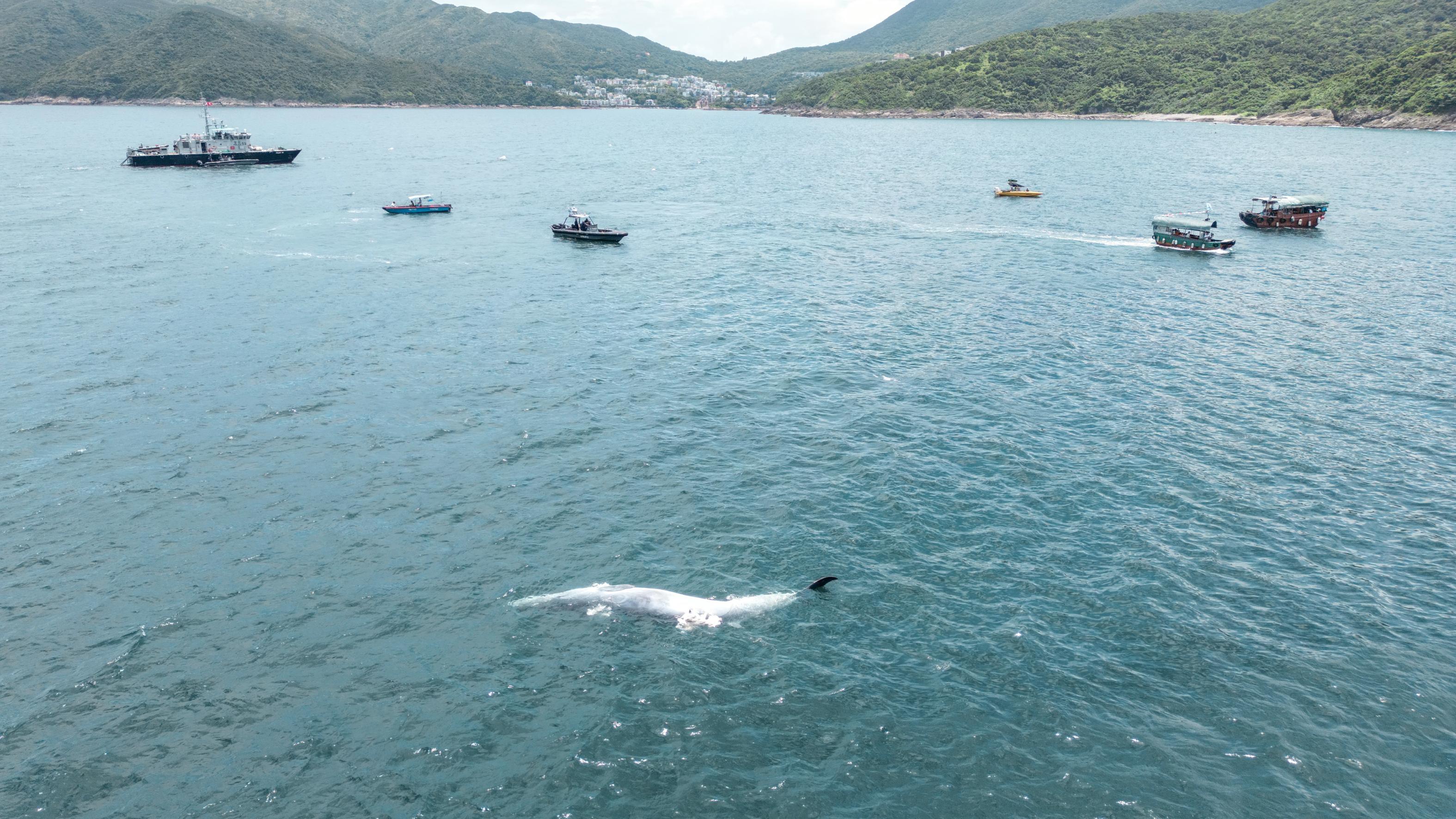 A Bryde's whale carcass is seen off Shelter Island in Sai Kung on July 31, 2023. (PHOTO PROVIDED TO CHINA DAILY)
A Bryde's whale carcass is seen off Shelter Island in Sai Kung on July 31, 2023. (PHOTO PROVIDED TO CHINA DAILY)
The death of an 8-meter long whale that was found in Hong Kong waters is believed to have been caused by strikes from a ship’s propeller, said Howard Chuk Hau-chung, director of the Ocean Park Conservation Foundation Hong Kong.
Hong Kong’s environmental chief pledged to adopt a series of measures to better protect such wild animals, including empowering government departments with more authority to respond to such incidents, and specifying distances that boats must maintain away from large whales.
The whale is thought to be a Bryde's whale, which is a first-class protected animal in China. It was first spotted in waters off Sai Kung in mid-July, prompting residents and travelers to rent boats to venture out to watch and chase after it. On July 31, the whale’s carcass was found off Shelter Island in Sai Kung.
Addressing reporters on Tuesday, Howard Chuk Hau-chung, director of the Ocean Park Conservation Foundation Hong Kong, summarized the three main causes of whale deaths based on previous cases: internal organ damage; damage from the marine environment, caused by, for example, the consumption of marine garbage; and external injuries, such as those caused by contact with boats
A group of experts from the Agriculture, Fisheries and Conservation Department, Hong Kong Ocean Park Conservation Fund, and City University of Hong Kong, dissected the whale on Tuesday to investigate the cause of its death.
The autopsy revealed two large, bone-deep wounds to the whale’s flesh, which may have become infected, reducing the chances of its survival. The whale’s organs, baleen and other reproductive organs were sent for testing.
Addressing reporters on Tuesday, Chuk summarized the three main causes of whale deaths based on previous cases: internal organ damage; damage from the marine environment, caused by, for example, the consumption of marine garbage; and external injuries, such as those caused by contact with boats.
ALSO READ: Whale carcass found off Shelter Island in Sai Kung
He said that the whale's autopsy ruled out damage caused by the marine environment, adding that a sample from the whale's carcass has been sent abroad for further testing to check for any lesions.
Hong Kong Secretary for Environment and Ecology Tse Chin-wan acknowledged the difficulties involved in setting up a no-ship zone and urged the public not to harass wild animals.
He added that the HKSAR government would implement a series of measures to better protect such wild animals, which include strengthening public education on how to treat wild animals and formulating contingency plans to better protect whales entering Hong Kong waters.
It will also revise related laws to empower the AFCD with more authority to respond to such incidents, and will consider reviewing the dolphin-watching guidelines to include specific distances that boats must maintain when in the vicinity of large whales.
Hong Kong Secretary for Environment and Ecology Tse Chin-wan said the HKSAR government would implement a series of measures to better protect such wild animals, which include strengthening public education on how to treat wild animals and formulating contingency plans to better protect whales entering Hong Kong waters
Taison Chang Kai-tai, chairman of the Hong Kong Dolphin Conservation Society, called for a thorough investigation and possible prosecution if it is confirmed that the whale was hit by a ship’s propeller.
He also pointed out that Hong Kong's Wild Animals Protection Ordinance covers far fewer species of wild animals than the Chinese mainland's national list of protected wild animals. Hong Kong’s ordinance only covers 4 genera and 18 species of wild animals, as well as all wild birds, while 1,000 species of wild animals are included on the mainland's list.
READ MORE: Public urged to keep away from injured whale
At the end of June two years ago, a Bryde's whale was also found in the waters near Shenzhen's Dapeng.
The Shenzhen government set a temporary control zone in the area, prohibiting tourist boats from lingering and fishing boats from operating in the area. Cargo ships and engineering vessels were required to travel at low speeds within the designated area, and any violation would have resulted in accountability.
The control zone's boundaries were also adjusted periodically based on the whale’s activity until it left Shenzhen waters.
Mike Wong contributed to the story


